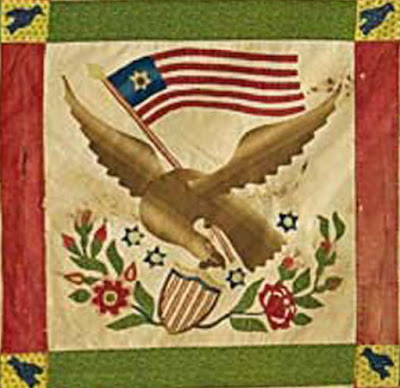Quilt dated 1853 Severn District, Maryland
The motto: E Pluribus Unum (One from Many)
Since I couldn't find any quilts from this fair I thought I'd throw
in some union images from Baltimore quilts of the 1850s.
Baltimore, 1864
Seated women in the center appear to be demonstrating the art of quilting in 1864 at the Baltimore Sanitary Fair. They are perhaps part of the "New England Kitchen," the scene of "old-fashioned quilting parties," according to Gloria Seaman Allen's essay "Maryland Women and the Civil War," in the book A Maryland Album.
Baltimore Sanitary Fair at the Maryland Institute
Frank Leslies's Illustrated Newspaper, May 14, 1864
Frank Leslie's illustration gives us a pretty view of the Union fundraising fair held for weeks in April and May, 1864.
The Maryland Institute was on the second floor (a two-story hall) above the
Centre Market on Market Street. The building
was razed in 1904
Side View
Shown on the Antiques Road Show
Items for sale are hung on the wall.
Those under Allegany County's misspelled sign appear to be clothing.
Allen: "Different counties sponsored fancy tables and raffled and sold blankets, quilts, and other household articles."
Ann Arundel County Booth & the Post Office
The Post Office was a standard fair feature where pretty women
sold clever letters.
From an Alex Cooper auction
"Despite the apparent solidarity of the state’s loyal population, the Maryland Fair could only be termed a modest financial success when compared with similar 1864 events. The final tally exceeded just over $83,000. In contrast, both the New York and Philadelphia fairs each cleared over $1,000,000.....While competition for donations from other cities most likely affected Maryland’s net amount, both economic realities and the state’s political division did factor largely."
Souvenir CDV of the children's department,
but what's in that stack?
The state and the city were certainly divided politically. Maryland was a border state less than fifty miles south of the Mason-Dixon line. Aligned with Northern culture and the Northern economy Maryland remained a Union state despite strong Confederate feeling from a minority.
The Fair's organizers were prominent women Fanny Turnbull, Harriet King Hyatt, Elizabeth Kell Bradford and Annie M. Gilman Bowen. President Lincoln came to give a speech at the Fair and Mary Todd Lincoln spent a day, escorted by fair organizers Elizabeth Bradford and Fanny Owings Nisbet Turnbull (1818-1881). Turnbull descendants have treasured the thank-you letter Lincoln sent. Her nephew Samuel Graeme Turnbull was a Confederate soldier who died of diptheria in 1862, only one instance of divided loyalties in the city.
Harriet Randolph King Hyatt (1814-1901) was wife of Baltimore merchant Alpheus Hyatt and lived in a mansion called Wansbeck at the corner of Franklin and Schroeder Streets. Her son Alpheus II joined the Union Army but his biography notes he and his Union-sympathizing mother were not in accordance with the rest of the family.
Maryland Institute Building about 1870 on Baltimore Street looking west
Photographers: Joshua W. Moulton & John S. Moulton
The Hyatt's home in 1911
when it was an orphan's asylum
The younger Alpheus Hyatt survived the war
to become a respected biologist.
Co-chair Elizabeth Kell Bradford (1818-1894) was Governor Augustus Bradford's wife. The family was enough of a Union symbol that Confederate troops burned their house a month or two after the fair in the closest raid the South made to Baltimore
Annie Gilman Bowen (1829-1903) may have been the fair organizer with the greatest family conflict. She was born in Charleston, South Carolina to Caroline Howard and Samuel Somes Gilman. Annie's parents had moved there from Massachusetts so Samuel could serve a Unitarian church.
Annie in turn moved to Baltimore when her husband took a post at a Unitarian Church there, but he was a Bostonian and so was she at heart. We don't know what Caroline thought of her daughter's public role in supporting the Union at the Sanitary Fair.
Annie Gilman Bowen (1829-1903) may have been the fair organizer with the greatest family conflict. She was born in Charleston, South Carolina to Caroline Howard and Samuel Somes Gilman. Annie's parents had moved there from Massachusetts so Samuel could serve a Unitarian church.
Caroline Howard Gilman (1794-1888)
by John Wesley Jarvis
Harvard Art Museums
Annie's mother Caroline Gilman became a female voice of the South editing a periodical The Southern Rose when Annie was a child. Her Recollections of a Southern Matron was a popular novel revealing her impressions of her new home. Annie's mother became a committed Southerner, supporting the cause throughout the war and after, writing that slavery was "the strength and almost the very life-blood of this Southern Region."
Some of my BAQ detail shots are pretty small but you get the idea
Annie in turn moved to Baltimore when her husband took a post at a Unitarian Church there, but he was a Bostonian and so was she at heart. We don't know what Caroline thought of her daughter's public role in supporting the Union at the Sanitary Fair.
Classic BAQ eagle from a quilt sold at a Hap Moore auction
Schoeberlein, Robert W. "A Fair to Remember: Maryland Women in Aid of the Union. Maryland Historical Magazine 1995.




















4 comments:
What is the deal with the first comment?
I'm wondering about the cdv of the girl beside the wishing well. What is the source for the image?
That is likely what was called "Jacob's Well" or else a wishing well. The sacks appear to be sandbags.
The cdv appeared on the Internet several years ago without a source citation.
Post a Comment